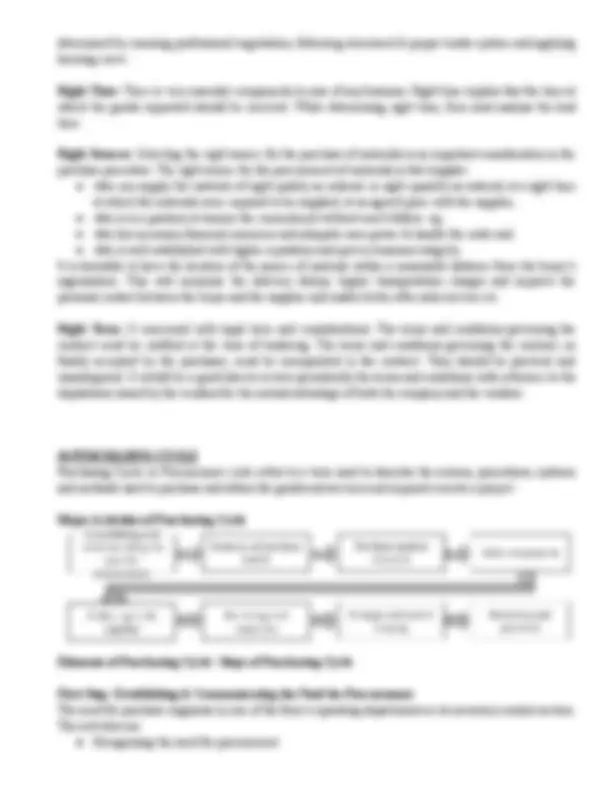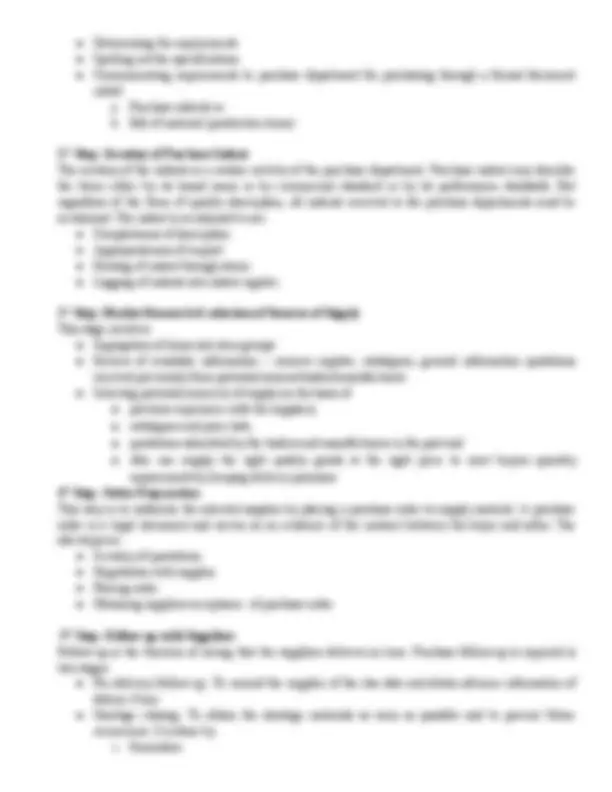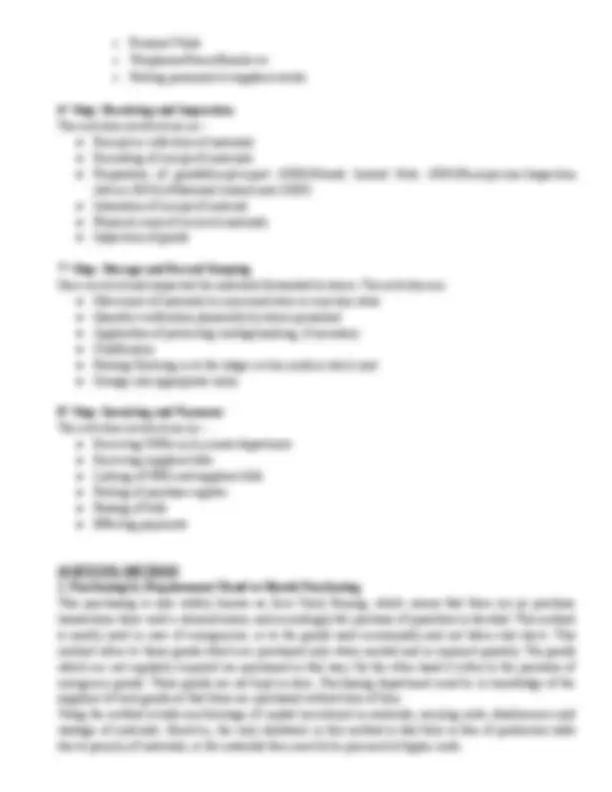





Study with the several resources on Docsity

Earn points by helping other students or get them with a premium plan


Prepare for your exams
Study with the several resources on Docsity

Earn points to download
Earn points by helping other students or get them with a premium plan
Community
Ask the community for help and clear up your study doubts
Discover the best universities in your country according to Docsity users
Free resources
Download our free guides on studying techniques, anxiety management strategies, and thesis advice from Docsity tutors
An overview of purchase management, including its meaning, objectives, and principles. It covers the role of purchasing in obtaining the right quantity and quality of goods and services, ensuring prompt delivery, and developing good supplier relationships. The document also introduces the 6 R's of purchasing and the purchasing process, from recognizing the need for procurement to receiving and inspection.
Typology: Schemes and Mind Maps
1 / 7

This page cannot be seen from the preview
Don't miss anything!




Purchase management is concerned with the procurement of proper equipment, materials and supplies of the right quantities, at the right prices at the right time. “Purchasing is the procuring of materials, supplies, machines tools and services required for the equipment, maintenance and operation of manufacturing plant”. Alford and Beatty. “Scientific purchasing means procurement by purchase of the proper materials, machinery, equipment and supplies or stores used in the manufacture of a product, adopted to marketing in the proper quantity and quality at the proper time, and at the lowest price consistent with the quality desired.”- —Dr. Walters ## OBJECTIVES OF PURCHASE MANAGEMENT Purchasing is responsible for establishing the flow of materials into the firm, following up with the supplier, and expediting delivery. The objectives of purchasing can be divided into four categories: ● To obtain goods and services of the required quantity and quality. ● To obtain goods and services at the lowest cost. ● To ensure the best possible service and prompt delivery by the supplier. ● To develop and maintain good supplier relations and develop potential suppliers. Following are the objectives of purchasing:
procurement based on the company's needs and goals, evaluate suppliers and develop long-term relationships across the supply chain. ● Operational purchasing, also known as tactical purchasing, takes care of the administrative aspects of purchasing. It's a short-term, transactional role which focuses on repeat ordering, receiving inventory and invoice payments as well as the handling of returns and complaints.. The followings are some of the important functions of purchasing department which are necessary to be performed.
● Determining the requirements ● Spelling out the specifications ● Communicating requirements to purchase department for purchasing through a format document called a. Purchase indents or b. Bill of material (production items) 2 nd^ Step: Scrutiny of Purchase Indent The scrutiny of the indents is a routine activity of the purchase department. Purchase indent may describe the items either by its brand name or by commercial standard or by its performance standards. But regardless of the form of quality description, all indents received in the purchase departments must be scrutinized. The indent is scrutinized to see: ● Completeness of description ● Appropriateness of request ● Routing of indent through stores ● Logging of indents into indent register 3 rd^ Step: Market Resaerch & selection of Sources of Supply This stage involves ● Segregation of items into item groups ● Review of available information – sources register, catalogues, general information quotations received previously from potential sources/traders/manufacturers ● Selecting potential source(s) of supply on the basis of o previous experience with the suppliers, o catalogues and price lists, o quotations submitted by the traders and manufacturers in the past and o who can supply the right quality goods at the right price to meet buyers quantity requirements by keeping delivery promises 4 th^ Step: Order Preparation This step is to authorize the selected supplier by placing a purchase order to supply material. A purchase order is a legal document and serves as an evidence of the contract between the buyer and seller. The sub-steps are: ● Scrutiny of quotations ● Negotiation with supplier ● Placing order ● Obtaining suppliers acceptance of purchase order 5 th^ Step: Follow-up with Suppliers Follow-up is the function of seeing that the suppliers delivers on time. Purchase follow-up is required in two stages: ● Pre-delivery follow-up: To remind the supplier of the due date and obtain advance information of delays, if any. ● Shortage chasing: To obtain the shortage materials as soon as possible and to prevent future recurrences. It is done by o Reminders
o Personal Visits o Telephones/Faxes/Emails etc o Posting personnel at suppliers works 6 th^ Step: Receiving and Inspection: The activities involved are as – ● Receipt or collection of materials ● Recording of receipt of materials ● Preparation of goods0rceipt-report (GRR)/Goods Inward Note (GIN)/Receipt-cum-Inspection Advice (RCIA)/Materials Inward note (MIN) ● Intimation of receipt of material ● Physical count of received materials ● Inspection of goods 7 th^ Step: Storage and Record Keeping Once received and inspected the materials forwarded to stores. The activities are- ● Movement of materials to concerned store or rejection store ● Quantity verification physically by stores personnel ● Application of protecting coating/marking, if necessary ● Codification ● Posting/ Entering in to the ledger or bin cards or stock card ● Storage into appropriate racks 8 th^ Step: Invoicing and Payment: The activities involved are as – ● Receiving GRRs in Accounts department ● Receiving suppliers bills ● Linking of GRR and suppliers bills ● Posting of purchase register ● Passing of bills ● Effecting payments ## BUYING METHOD
1. Purchasing by Requirement/ Hand to Mouth Purchasing : This purchasing is also widely known as Zero Stock Buying, which means that there are no purchase transactions done until a demand arises, and accordingly the purchase of quantities is decided. This method is mostly used in case of emergencies, or to the goods used occasionally and not taken into stock. This method refers to those goods which are purchased only when needed and in required quantity. The goods which are not regularly required are purchased in this way. On the other hand it refers to the purchase of emergency goods. These goods are not kept in store. Purchasing department must be in knowledge of the suppliers of such goods so that these are purchased without loss of time Using the method avoids any blockage of capital investment in materials, carrying costs, obsolescence and wastage of materials. However, the only drawback in this method is that there is fear of production halts due to paucity of materials, or the materials then need to be procured at higher costs.
7. Group Purchasing of Small Items: Sometimes a number of small items are required to be purchased. The prices of these items are so small that costs of placing orders may be more than prices. In such situations the buyer places order with a vendor for all these items. The purchase price is agreed to be by adding some percentage of profit in the dealer’s cost. This method will be used only when dealer’s records are open to inspection for determining his cost. This type of purchasing reduces the cost of the buyer by eliminating much clerical work. 8. Co-operative Purchasing: Small industrial units may join to pool their requirements and then place bulk orders with dealers. This will help them in availing rebates on large quantity purchases, cash discounts and savings in transportation costs. After receiving the materials these are divided among the member units. Co-operative purchasing helps small units in availing the benefits of bulk purchasing.